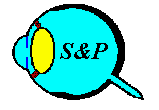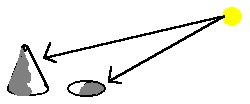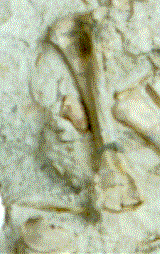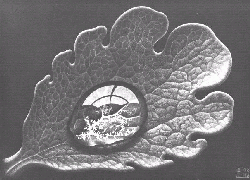

 Most objects in the world do not let much light
pass through so that these objects cast shadows. The exact shape and description of
the shadows changes depending on the direction of the light, e.g. when outside shadows are
long and go to the west in early morning, short and northerly at noon, and then long but
to the east in the late afternoon. However, there are certain general rules about shadows.
First, in a place with only one source of light, e.g. outside, the shadows from all the
objects in the area all go in the same direction. As a corrollary of this rule, it is
certainly true for all natural lights, and for most artificial lights, that the light
comes from above to some degree. We do not usually experience getting illuminated from the
floor. Second, for a solid object sticking up the side of the object in shadow is the side
away from the light but for a hole in the ground, the shadow is on the side near the
light. The figure to the right of this paragraph attempts to illustrate this idea, but you
can better see it with a coffee cup which is both standing up on the outside and has a
hole inside where you pour the coffee. Notice the shadows. On the outside, the shadows are
deepest on the opposite side from the inside of the cup.
Most objects in the world do not let much light
pass through so that these objects cast shadows. The exact shape and description of
the shadows changes depending on the direction of the light, e.g. when outside shadows are
long and go to the west in early morning, short and northerly at noon, and then long but
to the east in the late afternoon. However, there are certain general rules about shadows.
First, in a place with only one source of light, e.g. outside, the shadows from all the
objects in the area all go in the same direction. As a corrollary of this rule, it is
certainly true for all natural lights, and for most artificial lights, that the light
comes from above to some degree. We do not usually experience getting illuminated from the
floor. Second, for a solid object sticking up the side of the object in shadow is the side
away from the light but for a hole in the ground, the shadow is on the side near the
light. The figure to the right of this paragraph attempts to illustrate this idea, but you
can better see it with a coffee cup which is both standing up on the outside and has a
hole inside where you pour the coffee. Notice the shadows. On the outside, the shadows are
deepest on the opposite side from the inside of the cup.
The animation below illustrates how our assumptions about the direction of light plays a role in how we percieve an object. The image is a bone in the wall of Dinosaur National Monument. When the picture was taken, the light came from the right as indicated by the sun drawing. The top of the bone has an indentation. When the image flips we still assume that the sun is from the right. However the shadows with the indentation now are consistent with a bump not an indentation and most will see an bump (now at the bottom of the bone) and not an indentation. Let the image flip a few times and see for yourself.


| Shadow can play a very powerful role in defining form by
giving the object a three-dimensional feel as in the title to this page. In addition,
artists can take good advantage of shadow to define form by highlighting how different
portions of an object are at different depths and therefore the object closer to the light
will cast a shadow on the more distant object. The etching below by M.C. Escher of a leaf
uses shadow as the primary means of defining the form of the leaf that is in the sun. If
you look at the portion of the leaf that is lit up you will notice that lines are not
drawn for the veins in the leaf but shadow defines where they are. Shadow can play a broader role in defining depth between objects since objects that are in shadow must be farther from the light than objects that are not in shadow. |
 Dewdrop (Dauwdroppel) by M. C. Escher |